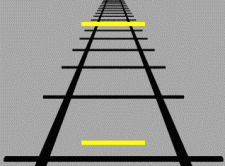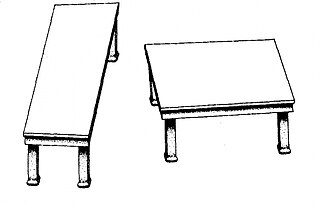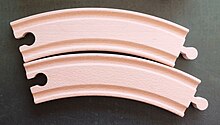
In visual perception, an optical illusion is an illusion caused by the visual system and characterized by a visual percept that arguably appears to differ from reality. Illusions come in a wide variety; their categorization is difficult because the underlying cause is often not clear but a classification proposed by Richard Gregory is useful as an orientation. According to that, there are three main classes: physical, physiological, and cognitive illusions, and in each class there are four kinds: Ambiguities, distortions, paradoxes, and fictions. A classical example for a physical distortion would be the apparent bending of a stick half immerged in water; an example for a physiological paradox is the motion aftereffect. An example for a physiological fiction is an afterimage. Three typical cognitive distortions are the Ponzo, Poggendorff, and Müller-Lyer illusion. Physical illusions are caused by the physical environment, e.g. by the optical properties of water. Physiological illusions arise in the eye or the visual pathway, e.g. from the effects of excessive stimulation of a specific receptor type. Cognitive visual illusions are the result of unconscious inferences and are perhaps those most widely known.

Gestalt psychology, gestaltism, or configurationism is a school of psychology that emerged in the early twentieth century in Austria and Germany as a theory of perception that was a rejection of basic principles of Wilhelm Wundt's and Edward Titchener's elementalist and structuralist psychology.

The Müller-Lyer illusion is an optical illusion consisting of three stylized arrows. When viewers are asked to place a mark on the figure at the midpoint, they tend to place it more towards the "tail" end. The illusion was devised by Franz Carl Müller-Lyer (1857–1916), a German sociologist, in 1889.

Experimental psychology refers to work done by those who apply experimental methods to psychological study and the underlying processes. Experimental psychologists employ human participants and animal subjects to study a great many topics, including sensation & perception, memory, cognition, learning, motivation, emotion; developmental processes, social psychology, and the neural substrates of all of these.

The McGurk effect is a perceptual phenomenon that demonstrates an interaction between hearing and vision in speech perception. The illusion occurs when the auditory component of one sound is paired with the visual component of another sound, leading to the perception of a third sound. The visual information a person gets from seeing a person speak changes the way they hear the sound. If a person is getting poor-quality auditory information but good-quality visual information, they may be more likely to experience the McGurk effect. Integration abilities for audio and visual information may also influence whether a person will experience the effect. People who are better at sensory integration have been shown to be more susceptible to the effect. Many people are affected differently by the McGurk effect based on many factors, including brain damage and other disorders.

Psychophysics quantitatively investigates the relationship between physical stimuli and the sensations and perceptions they produce. Psychophysics has been described as "the scientific study of the relation between stimulus and sensation" or, more completely, as "the analysis of perceptual processes by studying the effect on a subject's experience or behaviour of systematically varying the properties of a stimulus along one or more physical dimensions".

The Moon illusion is an optical illusion which causes the Moon to appear larger near the horizon than it does higher up in the sky. It has been known since ancient times and recorded by various cultures. The explanation of this illusion is still debated.

Psychology is defined as "the scientific study of behavior and mental processes". Philosophical interest in the human mind and behavior dates back to the ancient civilizations of Egypt, Persia, Greece, China, and India.

The Ponzo illusion is a geometrical-optical illusion that was first demonstrated by the Italian psychologist Mario Ponzo (1882–1960) in 1913. He suggested that the human mind judges an object's size based on its background. He showed this by drawing two identical lines across a pair of converging lines, similar to railway tracks. The upper line looks longer because we interpret the converging sides according to linear perspective as parallel lines receding into the distance. In this context, we interpret the upper line as though it were farther away, so we see it as longer – a farther object would have to be longer than a nearer one for both to produce retinal images of the same size.

The Ehrenstein illusion is an optical illusion of brightness or colour perception. The visual phenomena was studied by the German psychologist Walter H. Ehrenstein (1899–1961) who originally wanted to modify the theory behind the Hermann grid illusion. In the discovery of the optical illusion, Ehrenstein found that grating patterns of straight lines that stop at a certain point appear to have a brighter centre, compared to the background.

The Wundt illusion is an optical illusion that was first described by the German psychologist Wilhelm Wundt in the 19th century. The two red vertical lines are both straight, but they may look as if they are bowed inwards to some observers. The distortion is induced by the crooked lines on the background, as in the Orbison illusion. The Hering illusion produces a similar, but inverted effect.

The Zöllner illusion is an optical illusion named after its discoverer, German astrophysicist Johann Karl Friedrich Zöllner. In 1860, Zöllner sent his discovery in a letter to physicist and scholar Johann Christian Poggendorff, editor of Annalen der Physik und Chemie, who subsequently discovered the related Poggendorff illusion in Zöllner's original drawing.

Richard Langton Gregory, was a British psychologist and Professor of Neuropsychology at the University of Bristol.
Subjective constancy or perceptual constancy is the perception of an object or quality as constant even though our sensation of the object changes. While the physical characteristics of an object may not change, in an attempt to deal with the external world, the human perceptual system has mechanisms that adjust to the stimulus.

Joseph Jastrow was a Polish-born American psychologist notorious for inventions in experimental psychology, design of experiments, and psychophysics. He also worked on the phenomena of optical illusions, and a number of well-known optical illusions that were either first reported in or popularized by his work. Jastrow believed that everyone had their own, often incorrect, preconceptions about psychology. One of his ultimate goals was to use the scientific method to identify truth from error, and educate the layperson, which Jastrow accomplished through speaking tours, popular print media, and the radio.

The Ebbinghaus illusion or Titchener circles is an optical illusion of relative size perception. Named for its discoverer, the German psychologist Hermann Ebbinghaus (1850–1909), the illusion was popularized in the English-speaking world by Edward B. Titchener in a 1901 textbook of experimental psychology, hence its alternative name. In the best-known version of the illusion, two circles of identical size are placed near to each other, and one is surrounded by large circles while the other is surrounded by small circles. As a result of the juxtaposition of circles, the central circle surrounded by large circles appears smaller than the central circle surrounded by small circles.
In human visual perception, the visual angle, denoted θ, subtended by a viewed object sometimes looks larger or smaller than its actual value. One approach to this phenomenon posits a subjective correlate to the visual angle: the perceived visual angle or perceived angular size. An optical illusion where the physical and subjective angles differ is then called a visual angle illusion or angular size illusion.

The Delboeuf illusion is an optical illusion of relative size perception: In the best-known version of the illusion, two discs of identical size have been placed near to each other and one is surrounded by a ring; the surrounded disc then appears larger than the non-surrounded disc if the ring is close, while appearing smaller than the non-surrounded disc if the ring is distant. A 2005 study suggests it is caused by the same visual processes that cause the Ebbinghaus illusion.
Geometrical-optical illusions are visual illusions, also optical illusions, in which the geometrical properties of what is seen differ from those of the corresponding objects in the visual field.

Shepard tables are an optical illusion first published in 1990 as "Turning the Tables," by Stanford psychologist Roger N. Shepard in his book Mind Sights, a collection of illusions that he had created. It is one of the most powerful optical illusions, typically creating length miscalculations of 20–25%.


















